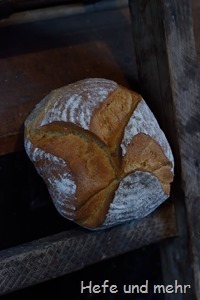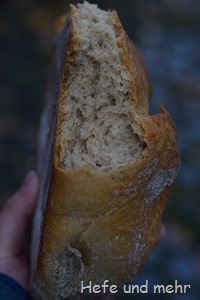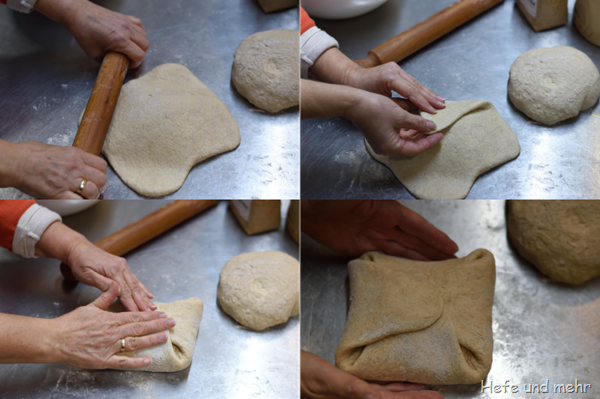After a lot of recipe development for my last course I have a lot of little flour leftovers from various ancient grains. There was for example the packet of white Kamut flour which I bought before I decided that the ancient grain workshop would be a whole grain workshop, too. And so I decided to use the last bread baking day in the museum to cut down some leftovers and baked pure kamut bread.
The bread contains about 40% whole grain flour which is mainly added to the poolish. That allows the flour to take up a lot of water. Especially Kamut is able to soak up a lot of water – at least all the batches I worked with in the last month. Anyway it is a good Idea to start with less water and add the water while kneading – just in case. The mild flaovur of the poolish fits very well to the nutty aroma of the Kamut.
As finding your own bread between all the other breads of the communal oven can be tricky, and so I take care to form my bread so they can be easy recognized. This time I shaped it first round and formed some “flaps” at its side and folded them to the middle. I used a similar technique for triangle breads, too!
Kamut-Packet
yields 2 Breads
- 250g whole kamut flour
- 300g Water
- 2g fresh yeast
Teig
- Poolish
- 600g white kamut flour
- 150g whole kamut flour
- 380g Water 1
- 20g Salt
- 6g fresh yeast
- 100g Water 2
Mix water, flour and yeast for the poolish and ferment it overnight (about 12 hours).
Mix all ingredients except the water 2 for the dough and knead it for about 5 min at low speed, then 8 min on high speed until medium gluten development. Turn back to low speed and knead water 2 in small portions into the dough.
Ferment over night in the fridge.
Divide the bread into 2 pieces and preform the dough to a balls. Let it rest for 5 – 10 min. Now flatten the sides of the ball, forming a higher square in the middle with “wings” attached to the triangle. Fold the “wings” into the middle so that a square is formed. Place thee loaves seamside down in a proofing basket.
Proof for 1.5 houra.
In the meantime heat the baking stone at 250°C.
Bake the breads for 50 min with steam, reducing the temperature to 200°C after 10 min.
Deutsch






Hallo Stefanie, kann ich auch Dinkelvollkornmehl verwenden? Ich habe nur helles Kamutmehl?
Viele deiner Rezepte dind in meiner all time favorite Sammlung.
Auch deine beiden Bücher sind klasse. Danke
@Christine: Ja, dass kannst du ganz problemlos machen! Und Danke für das Lob 😀
Heute endlich gebacken, sehr lecker.
Hallo,
wie viel länger müsste das Brot backen, wenn ich aus dem Teig keine zwei Brote sondern ein großes Brot backen will?
Muss ich noch etwas beachten (mehr Wasser), wenn ich es nur mit Vollkornmehl backen möchte?
Vielen Dank für deine Rezepte.
Schöne Grüße
Christian
@Christian: Du musst die Backzeit um etwa 15 min verlängern. Und bei Vollkornmehl wirst du mehr Wasser brauchen, ansonsten ändert sich an der Vorgehensweise nichts.
Warum hat dieses Brot noch keiner entdeckt ?
Der Teig ist unkompliziert in der Herstellung und ganz einfach auf zu arbeiten.
Und es schmeckt richtig gut und ist super saftig !
Also Stefanie, Kamut lasse ich mir in Zukunft noch öfter gefallen 😉
GlG, Nicole
Liebe Tochter, meine Hilfe kannst du jederzeit bekommen und das nicht ganz uneigennützig, denn die Nähe zur Backstube beinhaltet auch immer eine fast noch heiße Brotkostprobe die ich so besonders liebe.
Schon als kleines Kind durften meine Schwestern und ich meine Mutter zum Bäckerwagen begleiten. Dieser fuhr laut hupend durch die Siedlung. An unserer Parkbucht blieb er stehen, um mit seinem Hupen die Nachbarinnen zusammen zu rufen. Gemeinsam mit meiner Mutter vernaschten wir dann auf dem Heimweg den Kanten (Endstück) eines Brotes. In groben Stücken abgebrochen wurde diese Köstlichkeit an uns Kinder verteilt. Welch ein Genuss…….